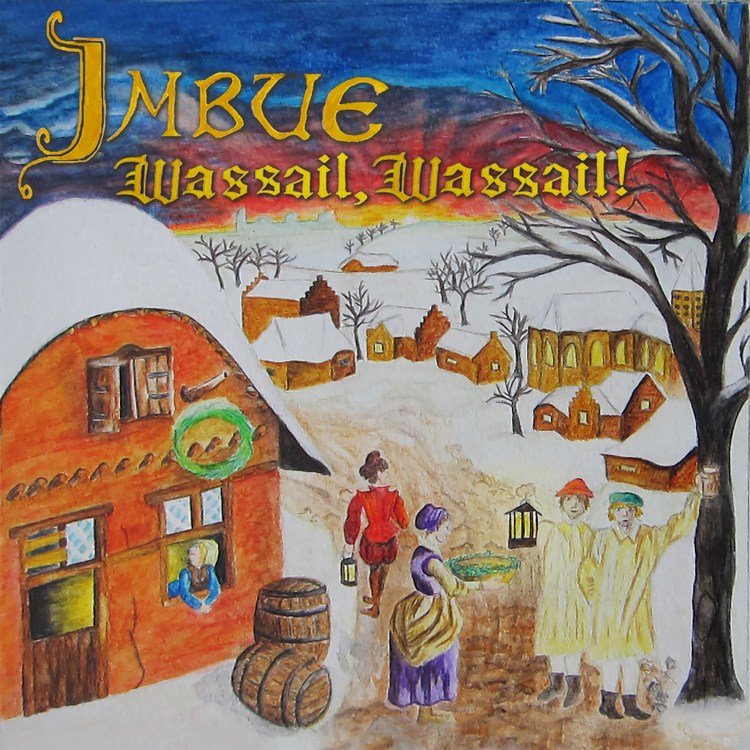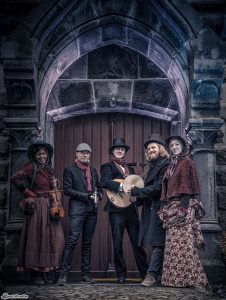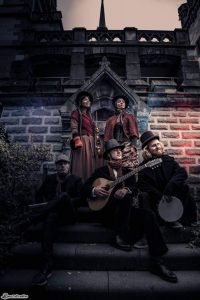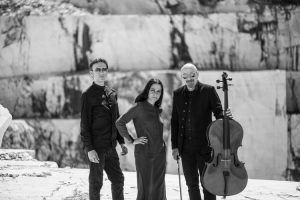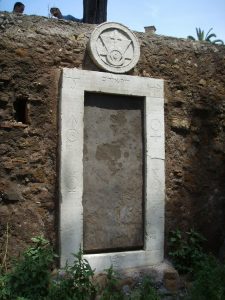
If I have to pick one word to describe this album it would be grand. It is Grand in the number of artists involved, (42 artists representing more than 20 bands are involved in this record); it is a grand gift from those artists to Castlefest; and grand is the word I want to use to describe the sound of the eight songs on this album. Rich and grand!
Grand was also my surprise when I heard the album for the first time. For me Castlefest is synonymous with cheerful danceable balfolk tunes and upbeat, organic pagan folk. It is a 4-day dance party that starts at 11:00 in the morning with the first balfolk workshops, and ends deep at night with the not-so-silent-disco. A four-day summer celebration.
This album feels totally different. As I said, it is majestic, impressive, orchestral, and totally not what I was expecting. A clear case of preconception. Something I always try to avoid as a reviewer, but this time I found it almost impossible not to do.
Luckily, I soon realized Hope Is The Thing With Feathers wasn’t meant as a ‘the best of Castlefest’ CD. We already have those. It wasn’t meant as a replacement Castlefest party. No, it was born out of the need to do something; to give some hope in a time when everything seems pushed out of place; to share love in a time when compassion is best given by keeping your distance. It’s born from the urge to make sense of it all, in the only way artists can, by putting it to music. That is what
The Castlefest Collective
is, a supergroup of artists coming together in a time we seem to be forced apart. Expressing what they felt when it happened and as it happened, giving it to us as a gift of hope.
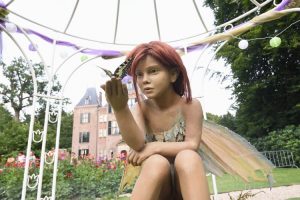
Sharing that message of hope starts straight away with the title track
Hope Is The Thing With Feathers. That intro so small; so touching. As always Laurens Krah
(
Pyrolysis)
manages to pull so much emotion out of his accordion. It sounds soft, sensitive, melancholic, and oh so touching. A sentiment easily fed by the vocals of Oliver Satyr and Adaya
(
Faun,
Adaya).
I’m taken right back to the days of
Folk Noir.
This is pagan singer/songwriter folk at its very, very best.
It is the piano of
Alex Nicola
that gives this delicate ballad some instant richness. A richness that is carried through into the second verse in the most beautiful of ways, adding sounds and accents as the song continues. A hurdy-Gurdy riff here, a mandolin accent there, and as a binding factor those oozing voices of Oliver and Adaya.
The best part is still to come, the build-up to the grand finale. First, the viola solo by Marijn Lammertink,
(
Scarred Grace,
and yes the sister of…)
which leads you into the recorder solo of Paya Lehane
(
PerKelt),
followed by verse three, before the Castlefest choir joins in for the first time. This goes way beyond anything I ever heard in pagan folk. This is Castlefest meeting
Night Of The Proms!
A true pagan folk rhapsody! Stunning! My first goosebumps moment!

But it is not the only song on
Hope Is The Thing With Feathers with a big, almost poplike sound.
Dark Lullaby is an impressive shanty-like song, the starting melody written by Corné van Woerdekom
(
Finvarra,
Scrum)
and the lyrics written by the ‘new kid on the block of the pagan folk scene’ Quentin Maltrud
(
Le Garçon de l’Automne).
This song will surely appeal to those who love the music of
Plunder,
Varend volk
and Faun.
Solstice Prayer has Paya and Rick Lehane written all over it. A song that could easily have been on Paya’s 2018 solo CD
Oppidamus. The beautiful doubled vocals of Paya and Sara
(
SeeD,
Anúna,
Systir),
combined with the haunting voice and throat singing of Michael Zann
(
Nemuer)
and the double hurdy-gurdy of Quentin and Yhandros Huergo
(
Cuélebre)
make this into a truly magical song.
Adiemus
meets pagan folk.
I already mentioned new talent Quentin in the two previous songs, but there is another new talent (for me at least) that I want to introduce.
Esme Knight
shines in two songs. First, there is
Fool Me, a pagan folk-rock song that reminds me a lot of the British band
Texas,
especially because of that typical slide guitar sound and Esme’s warm, ever so slight hoarse vocals. It is a cool grooving folk-rock song. (And whoever decided to hide
Herr Mannelig in there had a stroke of genius. I get a huge smile on my face every time I hear it.)
The second song Esme features in, is one of my highlights on this CD:
Now I Am The Sea. The first lines of the song are sung a capella and she nails it. Štěpán Honc (PerKelt), who produced and arranged this album, told me this is exactly how this song was born. Only a few instruments were added, most prominently a shamanistic drum, giving this song a real spiritual feel.

Now that I already dropped his name, this the moment I want to mention one of the artistic forces behind
Hope Is The Thing With Feathers, Štěpán Honc. He was the man behind the mixing desk, building up song after song, making sure every artist had their place, their special spot in all the songs, without overcrowding them. Not an easy feat, especially not when so many people are involved. The title song, for example, contains the sound of twelve(!) instruments, two lead singers, four supporting vocalists, and a choir of fourteen (14!) voices. All recorded separately, all of it build together like a giant Tetris puzzle of music. An amazing achievement, especially considering this is only the second album Štěpán produced. I first assumed Fieke van der Hurk was the lady in charge, that is how good this CD sounds. I can’t think of a bigger compliment than that.
Štěpán also co-wrote the second song that gives me goosebumps:
Where You’ve Never Been. Štěpán wrote the original guitar part, Taloch Jameson
(
The Dolmen)
wrote the lyrics, and last but not least Marijn Lammertink added a full orchestra score and choir to it. The resulting song has the quality of
The Moody Blues
(Nights In White Satin) written all over it.
The contrast between Taloch’s intense bluesy vocals and the grand orchestra and choir behind it is truly, truly stunning. Well done all involved!
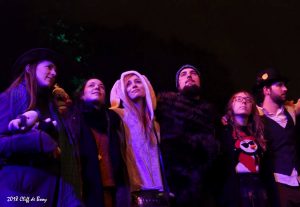 Mr. Happy
Mr. Happy is a goosebump moment of a totally different kind. To hear
Daphyd Sens
(
Thundercrow)
and Joe Hennon
(
Shantalla,
SeeD) team up once more just feels really special. Really special is also the way, in which Gwendolyn Snowdon’s voice
(Finvarra,
Gwendolyn Snowdon),
seems to perfectly merge with the deep sound of the slidgeridoo in this cheerful Americana-meets-folk tune.
Here’s To You is another American style folk song, written by Maarten van Vliet
(
The Royal Spuds)
ending this really special album.
As I said, this project was made possible because 42 artists came together on one album, all adding their talent to the music. If I added all of their names and contributions into this review it would become unreadable, so I opted not to. But every single person on this album played her or his part. Together they made something unique. A pop-folk pagan album that – at times – equals the heydays of ’60’s progressive rock. Think of bands like The Moody Blues,
Wallace Collection (Daydream),
or
John Miles (Music).
It is the beauty of pagan folk combined with the beauty of orchestral music, arranged in a true majestic style and served with a grand amount of Americana. Which brings us back to the very beginning of this review. This album can only be described with one word: Grand!
Epilogue:
The famous last words go to Stepan this time. After reading the finished review he got back to me with these words:
– “
Thank you for the great work, But since this ain’t a normal CD, can I allow myself one request? Could you please highlight the work of Rob van Barschot on drums and Sjoerd van Ravenzwaaij (Harmony Glen) on banjo through the whole album? They both went the extra 100 miles to make this album sound like a “band” and especially having a world-class drummer on a project like this is literally priceless… They don’t show off to steal the attention but make everyone else sounding like rock stars.‘
And THAT is the true spirit behind this project. It is also the true spirit behind the whole
Castlefest
scene. It is a scene of love, of caring for each other, of giving instead of taking. I talked to both Rob and Stepan in preparation for this review, and they had many words of praise for ALL the people involved in this album, not only the artists but also the people involved with the nitty-gritty bureaucratic side. And they were BOTH trying to downsize the role they themselves played in it. Luckily I talked to them both so I know both played a big role in it all.
Giving and caring is a virtue that sometimes seems lost in our modern money-driven society. I am so grateful I am part of a scene where it is still the norm. So thank you Castlefest Collective for giving us this music, thank you
Vana
for giving us a home, but especially thank you Castlefest visitors for giving this message of love and care again and again to the world!
Every time I come to Castlefest I feel like coming home. And ALL OF YOU, who make up this beautiful scene are the reason I feel that way! All of you; the dancers; the larpers; the pyrates; the furry’s, the pagans; and the ‘normal’ dressers. ALL of you make this scene a wonderful thing, and I thank you ALL for it, from the bottom of my heart! Thank You! See you all Next year!!!!!!!
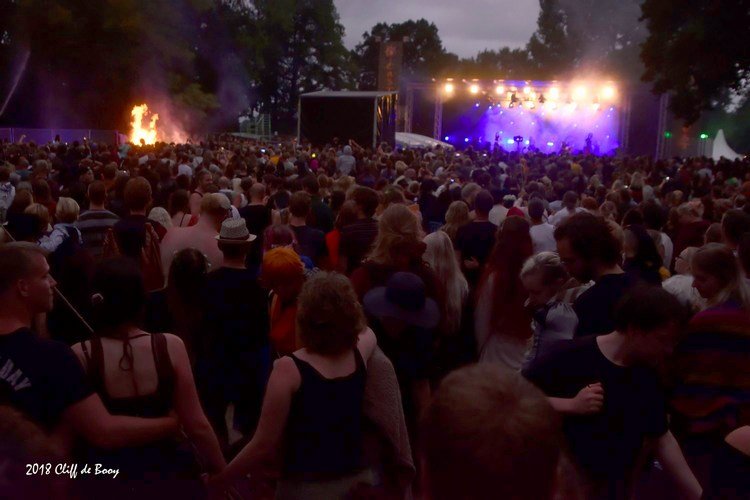
– Cliff
Pictures: Cliff de Booy
Editor: Anna
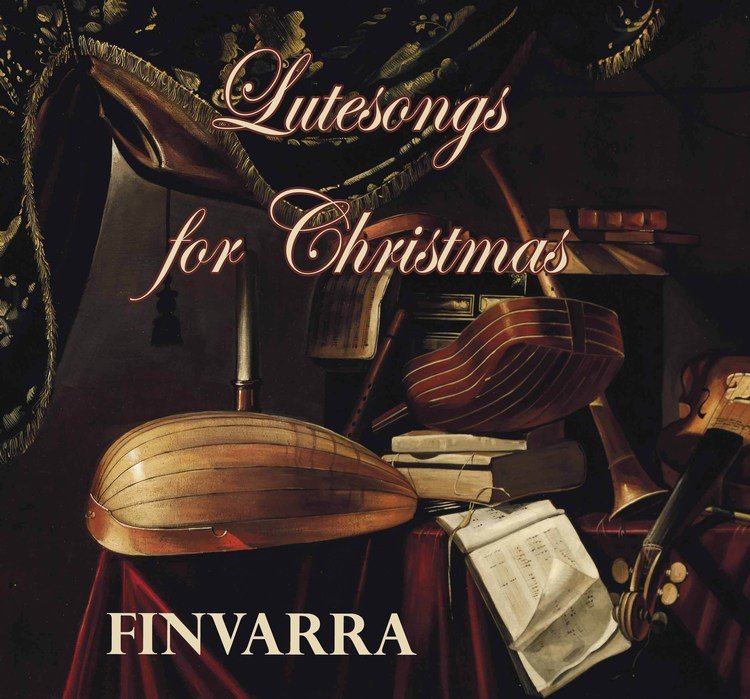
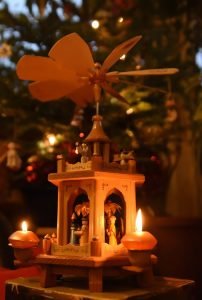 So here it is Lutesongs for Christmas. For me, Christmas stands for nostalgia, tradition, and warmth; some may even call me old fashioned but I’m fine with that. Every year I get out the stuffed Christmas animals; the straw angels; the old Christmas tree decorations and the German Christmas pyramid (left) Anna’s parents always set when she was young. I don’t even buy new Christmas decorations, I rather go into a second-hand store and search there, being totally happy to find a lovely glass-blown squirrel to hang in the tree. Add an old Christmas record to that and I am totally happy.
Luckily I am not the only one who thinks like that. Finvarra do as well. Just have a look at the instruments used on Lutesongs for Christmas: harpsichord; pump organ; recorder; violin; a music box; Baroque guitar, and of course -hence the title- a lot of instruments of the lute family: the theorbo; bouzouki; mandolin; the Arab ud and the lute itself, the list just oozes traditional music. and that is exactly what you are going to get. Traditional music…, with a twist.
Bells of the East starts simple enough, a nice windchill sound effect, sleighbells coming nearer from the distance, the gentle sound of glass beads hitting each other, and the calming sound of an oriental melody. Yes, I did say oriental! The mystical sound of the Arab ud and the theorbo take me deep into India. The oriental percussion by guest musician Sattar Al Saadi only enhances that feeling. The sleighbells returning at the very end of Bells of the East give me a slight sense of traveling through time and space. How wonderful. How unexpected. My imagination is running wild already.
The next song, I Saw Three Ships only increases that feeling of traveling. Originally a Christmas carol from the 17th century, especially popular in Cornwall, Finvarra recorded a highly danceable, light, almost fairy-like, instrumental version of it, made even lighter by adding a little ol’ jig Humours of Glendart in there.
Now I didn’t know about the origins of I Saw Three Ships, or Bells of the East the first times I listened to them, so the songs left me puzzled, intrigued, and wondering about the sense of it all. Why an oriental song on a Christmas album? The perfect moment for the third song to come: Wexford Carol.
This is the first ‘real’ Christmas song on this album. Traditionally it is an Irish Christmas Carol beautifully sung by Gwendolyn Snowdon (She easily is one of my favorite folk interpreters). There was one sentence in the lyrics that particularly struck me. It went: ‘In Bethlehem upon that morn‘. When I heard THAT sentence it suddenly occurred to me that, Christmas actually originated in the Middle East. In Israel. And if there were indeed three wise men from the east following a star, they must have come from Persia, India, or even a place beyond. All of a sudden those Oriental sounds made so much sense. It was at that point that I and this record clicked. This isn’t a ‘Rudolf-the-red-nosed-winterwonderland-have-a-lot-of-presents-in-the snow’ kind of CD. Finvarra set out to do something totally different.
The band always called themselves a Celtic & Oriental folk band, so it was only logical to have that Oriental touch returning on Lutesongs for Christmas. In the last two years Dieke Elfring and Patrick Broekema have studied Renaissance music and this felt like the perfect moment to use those beautiful instruments and play those old carols, rich in history and tradition.
For me, listening to Lutesongs for Christmas feels like traveling. Traveling back through time, traveling through cultures, traveling to lands far and wide. Just listen to IJswals, a lovely trip to medieval times, I can feel the lords and ladies slowly sliding through the great hall in a dance d’elegance’, celebrating the merry days of yule. Doesn’t it feel romantic?
Talking about those medieval times, Anna and me happened to watch a documentary on how Christmas was celebrated in Tudor times, The famous 12 days of Christmas. In that documentary, a choir performed the Coventry Carol. This carol is part of a mystery play traditionally performed in the 16th century in, indeed, Coventry. The carol itself refers to the Massacre of the Innocents, in which Herod ordered all male infants under the age of two in Bethlehem to be killed, and takes the form of a lullaby sung by mothers of the doomed children. Finvarra’s version is beautiful. Dieke Elfring’s voice is perfect for carrying such a heavy-themed lullaby. One of the best songs on the album
Entre le boeuf et l’âne gris (between the ox and the grey donkey) is another old traditional, again taking us back to medieval times. In this case, it is a French Christmas Carol and talks about little baby Jesus being born between an ox and a donkey.
As Patrick explained at the start of this review, Finvarra wanted to give us a gift with this album, they wanted to embrace us with warm and romantic Christmas music. Did they do that? Totally! The beauty of Lutesongs for Christmas is that Finvarra took those old Christmas carols and made them contemporary, while in keeping with the tradition of them all. They all ooze out warmth, tenderness, and that romantic peacefulness I so love about Christmas. The oriental side of Finvara just blends in perfectly, Songs like Bells of the West or Bells of the East I feel connect those traditional Renaissance songs with us, the ‘Castlefest generation’. Bells of the West has a beautiful pagan folk feel to it, as if
Daphyd Sens
and Faber Horbach
(Sowulo)
joined in for this celebration of Yule.
As I said, for me Lutesongs for Christmas sounds like I’m traveling through time, through music, and through history. As if Finvarra went through the mists of time and found us those special songs of solace played way back when, using it to give us a hug of warmth, and a blanket of tenderness in a time when we truly need that. And I love them for that.
– Cliff
editor: Anna Schürmann
cover art: Patrick Broekema
Picture: Cliff de Booy (1)
So here it is Lutesongs for Christmas. For me, Christmas stands for nostalgia, tradition, and warmth; some may even call me old fashioned but I’m fine with that. Every year I get out the stuffed Christmas animals; the straw angels; the old Christmas tree decorations and the German Christmas pyramid (left) Anna’s parents always set when she was young. I don’t even buy new Christmas decorations, I rather go into a second-hand store and search there, being totally happy to find a lovely glass-blown squirrel to hang in the tree. Add an old Christmas record to that and I am totally happy.
Luckily I am not the only one who thinks like that. Finvarra do as well. Just have a look at the instruments used on Lutesongs for Christmas: harpsichord; pump organ; recorder; violin; a music box; Baroque guitar, and of course -hence the title- a lot of instruments of the lute family: the theorbo; bouzouki; mandolin; the Arab ud and the lute itself, the list just oozes traditional music. and that is exactly what you are going to get. Traditional music…, with a twist.
Bells of the East starts simple enough, a nice windchill sound effect, sleighbells coming nearer from the distance, the gentle sound of glass beads hitting each other, and the calming sound of an oriental melody. Yes, I did say oriental! The mystical sound of the Arab ud and the theorbo take me deep into India. The oriental percussion by guest musician Sattar Al Saadi only enhances that feeling. The sleighbells returning at the very end of Bells of the East give me a slight sense of traveling through time and space. How wonderful. How unexpected. My imagination is running wild already.
The next song, I Saw Three Ships only increases that feeling of traveling. Originally a Christmas carol from the 17th century, especially popular in Cornwall, Finvarra recorded a highly danceable, light, almost fairy-like, instrumental version of it, made even lighter by adding a little ol’ jig Humours of Glendart in there.
Now I didn’t know about the origins of I Saw Three Ships, or Bells of the East the first times I listened to them, so the songs left me puzzled, intrigued, and wondering about the sense of it all. Why an oriental song on a Christmas album? The perfect moment for the third song to come: Wexford Carol.
This is the first ‘real’ Christmas song on this album. Traditionally it is an Irish Christmas Carol beautifully sung by Gwendolyn Snowdon (She easily is one of my favorite folk interpreters). There was one sentence in the lyrics that particularly struck me. It went: ‘In Bethlehem upon that morn‘. When I heard THAT sentence it suddenly occurred to me that, Christmas actually originated in the Middle East. In Israel. And if there were indeed three wise men from the east following a star, they must have come from Persia, India, or even a place beyond. All of a sudden those Oriental sounds made so much sense. It was at that point that I and this record clicked. This isn’t a ‘Rudolf-the-red-nosed-winterwonderland-have-a-lot-of-presents-in-the snow’ kind of CD. Finvarra set out to do something totally different.
The band always called themselves a Celtic & Oriental folk band, so it was only logical to have that Oriental touch returning on Lutesongs for Christmas. In the last two years Dieke Elfring and Patrick Broekema have studied Renaissance music and this felt like the perfect moment to use those beautiful instruments and play those old carols, rich in history and tradition.
For me, listening to Lutesongs for Christmas feels like traveling. Traveling back through time, traveling through cultures, traveling to lands far and wide. Just listen to IJswals, a lovely trip to medieval times, I can feel the lords and ladies slowly sliding through the great hall in a dance d’elegance’, celebrating the merry days of yule. Doesn’t it feel romantic?
Talking about those medieval times, Anna and me happened to watch a documentary on how Christmas was celebrated in Tudor times, The famous 12 days of Christmas. In that documentary, a choir performed the Coventry Carol. This carol is part of a mystery play traditionally performed in the 16th century in, indeed, Coventry. The carol itself refers to the Massacre of the Innocents, in which Herod ordered all male infants under the age of two in Bethlehem to be killed, and takes the form of a lullaby sung by mothers of the doomed children. Finvarra’s version is beautiful. Dieke Elfring’s voice is perfect for carrying such a heavy-themed lullaby. One of the best songs on the album
Entre le boeuf et l’âne gris (between the ox and the grey donkey) is another old traditional, again taking us back to medieval times. In this case, it is a French Christmas Carol and talks about little baby Jesus being born between an ox and a donkey.
As Patrick explained at the start of this review, Finvarra wanted to give us a gift with this album, they wanted to embrace us with warm and romantic Christmas music. Did they do that? Totally! The beauty of Lutesongs for Christmas is that Finvarra took those old Christmas carols and made them contemporary, while in keeping with the tradition of them all. They all ooze out warmth, tenderness, and that romantic peacefulness I so love about Christmas. The oriental side of Finvara just blends in perfectly, Songs like Bells of the West or Bells of the East I feel connect those traditional Renaissance songs with us, the ‘Castlefest generation’. Bells of the West has a beautiful pagan folk feel to it, as if
Daphyd Sens
and Faber Horbach
(Sowulo)
joined in for this celebration of Yule.
As I said, for me Lutesongs for Christmas sounds like I’m traveling through time, through music, and through history. As if Finvarra went through the mists of time and found us those special songs of solace played way back when, using it to give us a hug of warmth, and a blanket of tenderness in a time when we truly need that. And I love them for that.
– Cliff
editor: Anna Schürmann
cover art: Patrick Broekema
Picture: Cliff de Booy (1)
